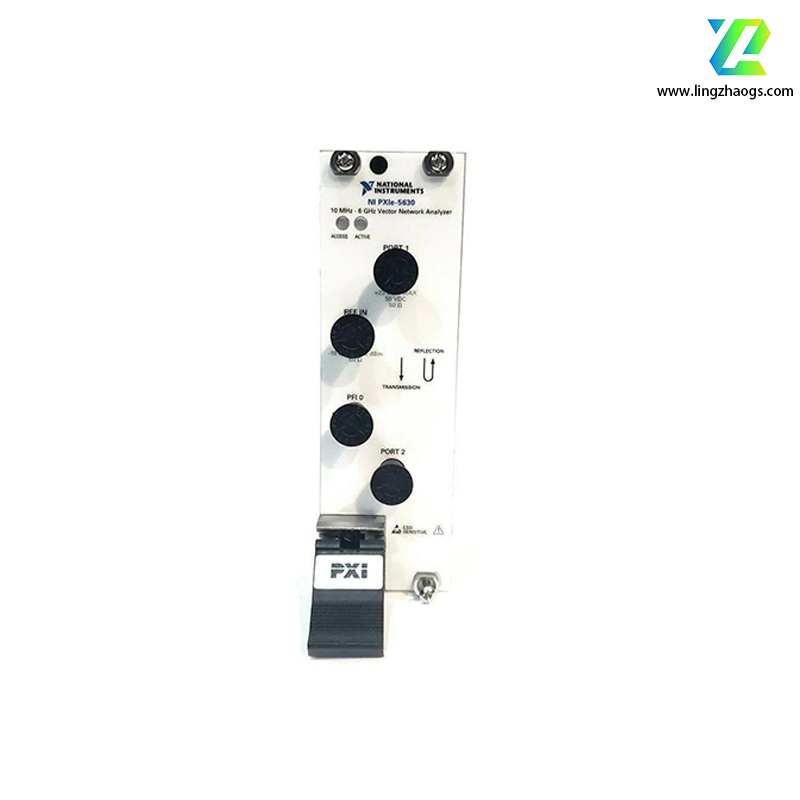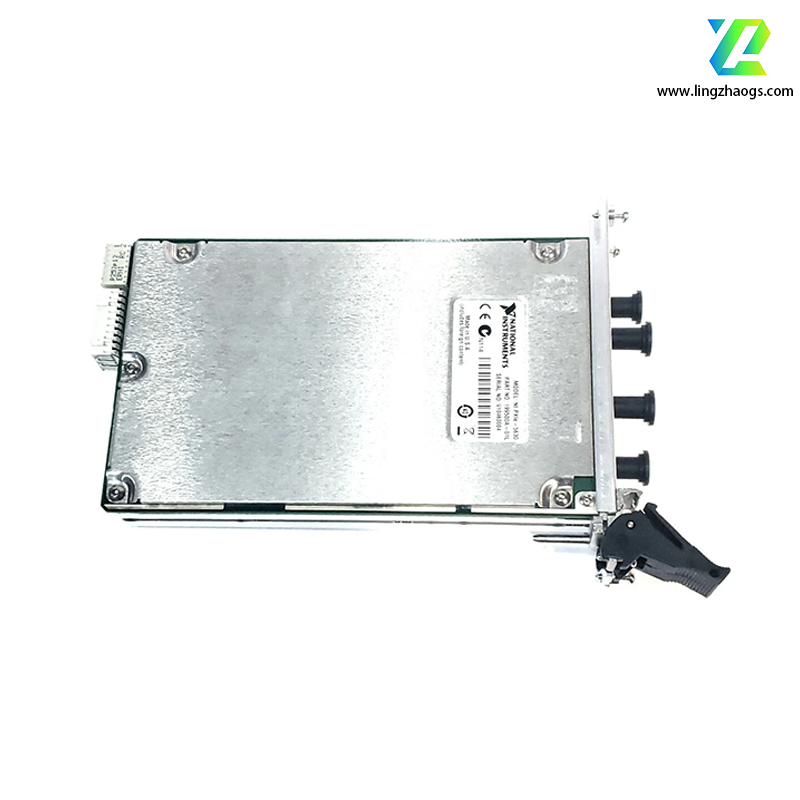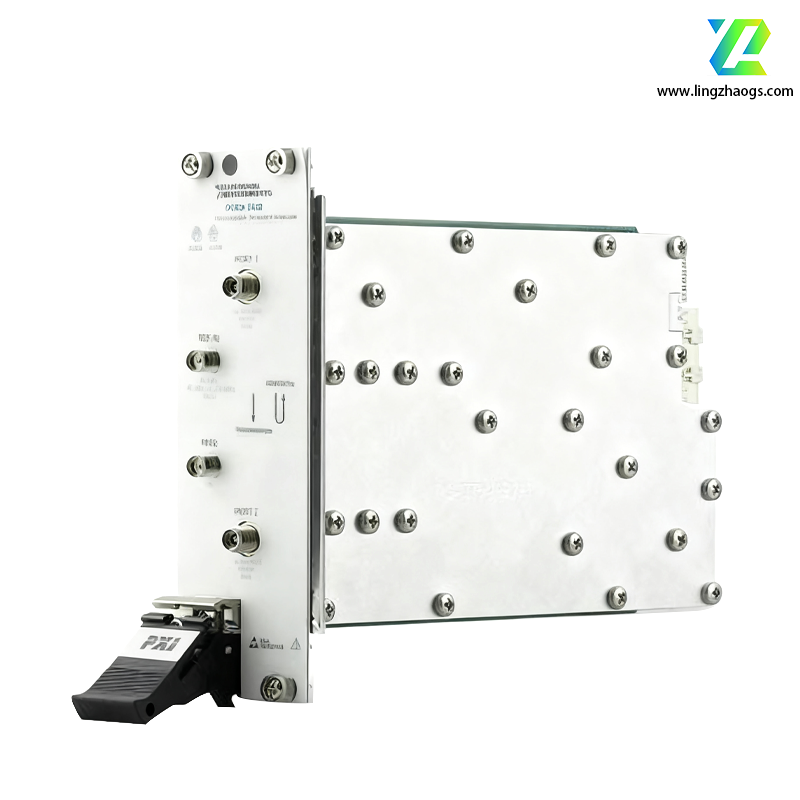The NI PXIe-5630 is a high-performance vector signal analyzer (VSA) designed for the PXI Express (PXIe) bus architecture, belonging to National Instruments (NI)’s flagship RF test product line. Its defining features include 3.6 GHz maximum RF input frequency, 14-bit high-resolution ADC, and 20 MHz real-time bandwidth—enabling precise analysis of complex modulated signals in applications such as wireless communication validation, aerospace/defense radar testing, and semiconductor RF component characterization. With excellent dynamic range and PXIe modular synchronization, it delivers laboratory-grade performance in a compact, scalable form factor.
- Module Series: PXIe High-Performance Vector Signal Analyzer (VSA)
- Part Numbers: 781089-01 (standard model); 781089-02 (extended temperature model)
- Physical Dimensions: 2-slot 3U PXIe form factor, 20.3 cm × 16.0 cm (width × length)
- Weight: Approximately 1.1 kg (2.43 lbs)
- Power Requirements:
- +3.3 V DC (2.0 A)
- +12 V DC (3.2 A)
- -12 V DC (0.5 A)
- Power consumption: Typical 40 W, Maximum 55 W
- Interface Type:
- PXIe x4 lane (up to 2 GB/s data transfer rate) for real-time signal streaming
- 2 SMA female connectors (RF Input 1, RF Input 2) for single-ended or differential RF signal acquisition
- 1 SMA female connector (External Trigger I/O) for synchronization
- 1 10-pin header (Auxiliary I/O) for clock reference and control signals
- Operating Temperature Range:
- Commercial grade: 0°C ~ 55°C
- Extended grade (model 781089-02): -40°C ~ 85°C (for harsh aerospace/defense environments)
- Environmental Ratings:
- Shock Resistance: 50 g peak (11 ms duration, half-sine)
- Vibration Resistance: 5 g RMS (10 Hz ~ 500 Hz, random)
- Ingress Protection: IP30 (prevents solid foreign object intrusion)
- Compliance: Meets FCC Part 15 Class A, CE EN 61326-1, UL 61010-1, and IEC 61010-1 safety & EMC standards
- Frequency Range: 9 kHz ~ 3.6 GHz (continuous coverage, no gaps)
- Input Configuration:
- 2 independent single-ended RF input channels (support for differential input via external balun)
- Input impedance: 50 Ω (standard, matched for RF signals)
- Input return loss: ≥18 dB (1 GHz ~ 3 GHz), ≥15 dB (3 GHz ~ 3.6 GHz)
- Input Power Handling:
- Maximum safe input power: +20 dBm (100 mW)
- Damage level: +30 dBm (1 W, 1 minute)
- Noise Performance:
- Noise Figure (NF): ≤9 dB (1 GHz, 1 MHz bandwidth, typical)
- Phase Noise: -118 dBc/Hz (1 GHz carrier, 10 kHz offset, typical)
- Dynamic Range:
- Spurious-Free Dynamic Range (SFDR): ≥75 dBc (1 GHz, 10 MHz bandwidth, typical)
- Third-Order Intercept Point (IP3): +12 dBm (typical, at 1 GHz)
- Adjacent Channel Power Ratio (ACPR): ≥70 dBc (for WCDMA signals, typical)
- ADC Resolution: 14-bit SAR (Successive Approximation Register) ADC, no missing codes
- Sampling Rate:
- Maximum real-time sampling rate: 125 MS/s (per channel)
- Equivalent Time Sampling (ETS): Supported for signals up to 3.6 GHz (extends bandwidth beyond real-time sampling)
- Bandwidth Options:
- Real-time bandwidth: Up to 20 MHz (at 125 MS/s sampling)
- Decimation filters: Programmable (1x, 2x, 4x, 8x) to reduce bandwidth and improve noise performance
- Anti-aliasing filter: 80 dB/octave roll-off (prevents frequency aliasing in sampled signals)
- Quantization Noise: -74 dBFS (typical, at full-scale input, 10 MHz bandwidth)
- Modulation Analysis: Supports all mainstream digital modulation formats, including:
- Cellular: 5G NR, LTE, LTE-A, WCDMA, GSM/EDGE
- Wireless LAN: Wi-Fi 4/5/6/6E (802.11b/g/n/ac/ax)
- Satellite: DVB-S2, QPSK, 8PSK, 16APSK
- Radar: FMCW, pulsed, phase-coded, frequency-hopped signals
- General: ASK, FSK, PSK (BPSK/QPSK/8PSK), QAM (16QAM/64QAM/256QAM)
- Key Measurements:
- Power Metrics: Average power, peak power, peak-to-average power ratio (PAPR), channel power, occupied bandwidth
- Modulation Quality: Error Vector Magnitude (EVM) (≤0.5% for QPSK), phase error, amplitude error, constellation diagram
- Spectral Metrics: Spurious emissions, harmonic distortion, adjacent channel leakage ratio (ACLR)
- Time-Domain Metrics: Pulse width, rise/fall time, overshoot, envelope tracking
- Onboard Processing:
- Xilinx Kintex-7 FPGA for real-time signal preprocessing (filtering, downconversion, demodulation)
- Supports custom signal processing IP cores (via LabVIEW FPGA) for specialized radar/communication signal analysis
- Clock Sources:
- Internal: 100 MHz OCXO (Oven-Controlled Crystal Oscillator), stability ±0.01 ppm/year
- External: 10 MHz reference input (via SMA connector), compatible with GPS disciplined oscillators (GPSDO)
- PXIe 10 MHz Backplane Clock: Synchronizable with other PXIe modules (e.g., signal generators, digitizers)
- Trigger Options:
- RF Edge Trigger: Rising/falling edge on RF input (threshold adjustable: -40 dBm ~ +10 dBm)
- Digital Trigger: TTL-compatible edge on external trigger I/O or PXIe trigger lines (PXIe_Trig 0~7)
- Pattern Trigger: Trigger on specific signal patterns (e.g., 5G NR preamble, radar sync words)
- Software Trigger: API-initiated trigger for automated test sequences
- Multi-Module Sync:
- Supports PXIe Star Trigger for nanosecond-level phase alignment across multiple PXIe-5630 modules (for MIMO testing)
- Phase-coherent operation with NI PXIe-5673 (signal generator) for closed-loop test systems
- Recommended Software:
- NI RFmx Measurement Suite (full package, includes modulation-specific toolkits for 5G, Wi-Fi, radar)
- LabVIEW 2020+ (for custom test program development, FPGA programming, and GUI design)
- NI TestStand (for test sequence automation, data logging, and report generation)
- NI SignalExpress (for quick, code-free signal validation and troubleshooting)
- Drivers:
- NI-RFSA (RF Signal Analyzer driver) for low-level hardware control, measurement configuration, and data acquisition
- NI-FGEN (compatible with signal generator modules for synchronized stimulus-response testing)
- Programming Compatibility:
- NI Ecosystem: Native support for LabVIEW, LabWindows/CVI, and Measurement Studio
- Third-Party Languages: Supports C/C++, C#, Python (via NI-RFSA Python bindings), and MATLAB (via NI-RFSA Toolbox)
- Scripting: Supports Python/LabVIEW scripting for batch testing (e.g., 5G UE conformance testing)
- Calibration Tools:
- Built-in automated calibration (via NI RFmx) for gain, offset, linearity, and phase correction
- Recommended calibration interval: 1 year (or after major temperature changes)
- External calibration support via NI Calibration Services (ISO 17025 accredited)
The NI PXIe-5630’s high precision and wide frequency coverage make it ideal for:
- 5G Communication Testing: 5G NR UE (User Equipment) and gNodeB (base station) conformance testing, including EVM measurement for high-order QAM (256QAM/1024QAM) and beamforming validation
- Aerospace & Defense: Radar signal characterization (FMCW, pulsed radar), satellite communication (SATCOM) link analysis (L-band/S-band), and electronic warfare (EW) signal monitoring (1 ~ 3.6 GHz)
- Semiconductor RF Testing: RFIC/MMIC characterization (e.g., power amplifiers, mixers, transceivers), wafer-level testing of 5G RF chips, and noise figure measurement of low-noise amplifiers (LNAs)
- Automotive Electronics: V2X (Vehicle-to-Everything) communication testing (C-V2X, DSRC), ADAS radar sensor validation (24 GHz/77 GHz, via external downconverter), and infotainment system RF interference testing
- Scientific Research: High-frequency physics experiments (e.g., particle accelerator RF signal analysis), radio astronomy (low-noise signal detection), and biomedical RF device testing (e.g., MRI RF coils)
- Ideal Use Cases: Applications requiring 3.6 GHz RF coverage, 20 MHz real-time bandwidth, and 14-bit precision; suitable for R&D, production test, and conformance testing of complex RF systems
- Comparison with Similar Models:
- vs. NI PXIe-5632: PXIe-5630 has 20 MHz real-time bandwidth (vs. 50 MHz for PXIe-5632) but identical frequency range; choose for lower-bandwidth, cost-sensitive tasks
- vs. NI PXIe-5665: PXIe-5630 is more compact (2-slot vs. 3-slot) but lower bandwidth (20 MHz vs. 1 GHz); ideal for space-constrained test systems
- System Integration:
- Chassis Compatibility: Requires NI PXIe chassis with 2 available slots (e.g., PXIe-1075, PXIe-1085) or third-party PXIe-compliant chassis
- Companion Modules:
- Signal Generation: Pair with NI PXIe-5673 (3.6 GHz vector signal generator) for closed-loop test systems
- Signal Conditioning: Use NI PXIe-5691 (RF preamplifier) to improve weak signal detection (reduces NF by 6 dB) or NI PXIe-5610 (RF downconverter) for extended frequency coverage beyond 3.6 GHz
- Switching: Integrate with NI PXIe-2543 (RF multiplexer) for multi-DUT testing (e.g., 8-channel RFIC production test)
- Limitations: Real-time bandwidth limited to 20 MHz (insufficient for ultra-wideband signals like 5G NR FR2); no built-in preamplifier (requires external module for very weak signals)
- Alternative Models:
- Higher Bandwidth: NI PXIe-5632 (50 MHz real-time bandwidth)
- Lower Cost: NI PXIe-5600 (1 GHz, 12-bit, entry-level)
- Ultra-Wideband: NI PXIe-5665 (3 GHz, 1 GHz real-time bandwidth)





